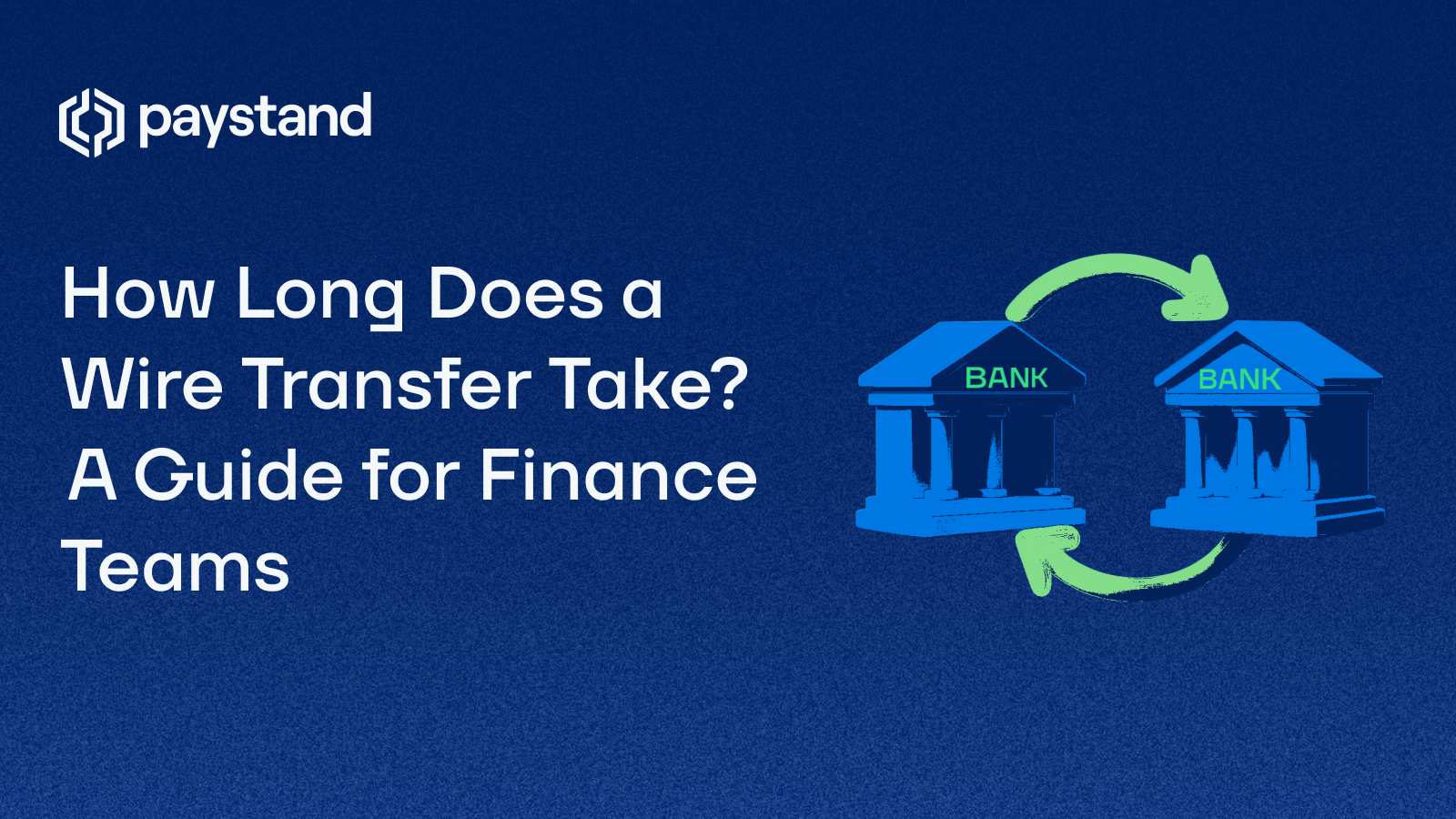How Long Does a Wire Transfer Take? A Guide for Finance Teams

Table of Contents
- What Exactly Is a Wire Transfer?
- Domestic Wire Transfers: Same‑Day Is the Norm
- How Long Does an International Wire Transfer Take?
- Online International Wire Transfers: Are They Faster?
- Why Your Wire Might Take Longer Than Expected
- Reducing Wire Friction — and Costs
Key Takeaways
- Domestic wires typically settle the same business day—often within hours—if you meet your bank’s cutoff time.
- International wires average one to five business days, slowed by intermediary banks, compliance screenings, and time‑zone gaps.
- Missing or incorrect beneficiary details and large‑value compliance reviews are the leading causes of delays.
- Online portals can shave a day off cross‑border transfers by automating data validation and enabling 24/7 initiation.
- Alternatives like ACH, SEPA, or push‑to‑card payments may be cheaper and nearly as fast for repeat transactions.
- Automating wire templates and integrating payment data with your ERP minimizes manual errors and accelerates reconciliation.
Wire transfers are the workhorses of modern B2B payments. When you need to move large sums quickly and securely, few rails beat the speed and finality of an electronic wire. But “quickly” can still feel ambiguous when vendors are waiting, cash‑flow forecasts depend on precise timing, and every extra day of float affects your bottom line.
Below, we break down the real‑world timelines—domestic and international—plus the factors that can speed things up (or slow them to a crawl).
What Exactly Is a Wire Transfer?
A wire transfer is a direct, bank‑to‑bank movement of funds executed over a secure network such as Fedwire or CHIPS in the U.S. For a deeper dive into how the process works, including fees and security protocols, check out Paystand’s primer on wire transfers.
Unlike ACH batches or card payments, wires settle individually in near‑real time once released by the sending institution—hence their popularity for high‑value, time‑sensitive transactions.
Domestic Wire Transfers: Same‑Day Is the Norm
For wires within the United States, same‑day settlement is typical as long as you meet the bank’s daily cutoff (often between 2:00 p.m. and 5:00 p.m. ET). The funds usually appear in the recipient’s account within a few hours.
Key factors that influence speed include:
- Cutoff times. Miss the window and the transfer rolls to the next business day.
- Payment reviews. Large amounts can trigger fraud checks, adding a short delay.
- Weekends and holidays. The Fedwire system operates only on U.S. banking days.
If your company frequently wires vendors but prefers a fully digital “set‑and‑forget” workflow, it may be worth comparing wires with direct deposits (ACH). ACH is slower—typically one to two business days—but costs dramatically less and can be automated end‑to‑end.
How Long Does an International Wire Transfer Take?
Cross‑border wires introduce extra hops, currency conversions, and compliance checks. On average, expect one to five business days from initiation to final credit:
| Stage | Typical Duration | What Can Delay It? |
|---|---|---|
| Sender’s bank processing | Same day | Missing documentation, late cutoff |
| SWIFT message routing | < 24 hours | Routing through multiple correspondent banks |
| Intermediary bank reviews | 1–2 days | OFAC or sanctions screening, AML flags |
| Recipient bank posting | Same day | Local banking holidays, time‑zone differences |
For a closer look at fees, exchange‑rate spreads, and best practices to reduce friction, see Paystand’s international wire transfer guide.
Online International Wire Transfers: Are They Faster?
Fintech platforms and challenger banks advertise “real‑time” or “one‑day” foreign wires. In reality, speed still hinges on the underlying correspondent network. However, online portals streamline the front end:
- Pre‑validated templates reduce data‑entry errors (no more guessing the SWIFT/BIC).
- Automated sanctions screening flags issues before submission.
- 24/7 initiation lets you beat bank‑branch cutoff times, shaving up to a day.
If you’re exploring alternatives, remember that “bank transfer” can also refer to ACH, SEPA, or Faster Payments depending on the corridor. Paystand’s overview of what constitutes a bank transfer clarifies the terminology so you can match rail to use case.
Why Your Wire Might Take Longer Than Expected
- Incorrect beneficiary details. A mismatched account number or routing code forces manual repair.
- Compliance reviews. Transfers over certain thresholds ($10 K in the U.S.) trigger mandatory reports.
- Time zones. A Friday afternoon transfer from Chicago to Singapore can effectively lose a weekend.
- Intermediary fees deducted in flight. Missing fees can cause the recipient bank to hold funds until shortfalls are covered.
- Legacy systems. Some credit unions and regional institutions still batch‑process SWIFT messages overnight.
Reducing Wire Friction and Costs
- Automate data capture. Integrate your ERP so invoices populate beneficiary data automatically.
- Use standing templates for repeat payees; lock them behind role‑based approvals.
- Validate counterparty information at onboarding; confirming a SWIFT/BIC once is faster than troubleshooting later.
- Explore alternatives for recurring payouts: ACH for domestic, SEPA for Europe, or even instant push‑to‑card disbursements. (Paystand’s rundown on push‑to‑card payments explains how funds can reach corporate cards in minutes.)
Domestic wires usually land within hours, while international wires clear in one to five business days—longer if compliance or intermediary banks intervene. By understanding cutoffs, validating details upfront, and choosing the right payment rail for each scenario, finance teams can keep cash moving without unpleasant surprises.
Ready to move beyond manual inputs and bank fees? Paystand’s zero‑fee, blockchain‑backed network automates payment flows right from your ERP, giving you faster reconciliations and real‑time visibility. Learn more by looking at our B2B automations page.







%20(1)%20(1).jpg?width=100&height=100&name=IMG_3752%20(1)%20(1)%20(1).jpg)